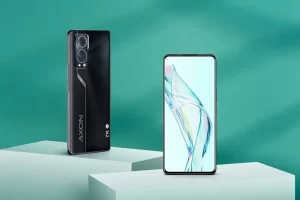The quest for a truly immersive smartphone experience has led manufacturers to push the boundaries of design—eliminating notches, bezels, and even front-facing cameras from our view. The ZTE Axon 30 is stepping into the spotlight with its under-display camera (UDC) technology, a feature once deemed futuristic. But does this innovation live up to the hype, and can it finally deliver the “full-screen” phone we’ve been promised? This article unpacks how the Axon 30’s UDC works, why it matters for smartphone evolution, and whether it’s a glimpse into the future of mobile tech.

(A close-up of the ZTE Axon 30’s display, showcasing the seamless integration of its under-display camera. Caption: “No notch, no compromise: The Axon 30’s hidden camera blends invisibly into the screen.”)
The Illusion of Perfection: How Under-Display Cameras Work
Traditional selfie cameras require a dedicated cutout, breaking the screen’s continuity. The Axon 30’s UDC flips this script by embedding the camera beneath a specially engineered OLED panel. Using a mesh-like pixel structure and transparent materials, light passes through the display to the sensor below, capturing crisp photos without visible hardware.
Tech experts at DisplayMate note that ZTE’s solution achieves 95% screen-to-body coverage, a leap over the 85–90% seen in devices with pop-up or under-display cameras. The secret lies in its Dynamic AMOLED 2X display, which balances transparency and color accuracy. Unlike early UDC attempts that suffered from blurry images, the Axon 30 uses AI algorithms to enhance low-light performance and reduce noise—proof that hardware and software innovation go hand-in-hand.
Design Freedom: Freedom from the Notch Era
The Axon 30’s UDC isn’t just about aesthetics; it redefines how we interact with our devices. Without a notch, apps and media can utilize the entire screen. Streaming platforms like Netflix and YouTube now display content in true Full HD+, while gaming feels more immersive with no interruptions.
Users have praised the phone’s Edge-to-Edge display for its cinematic appeal. A Reddit user shared, “Watching movies on this feels like staring at a window—there’s no awkward cutout ruining the experience.” Even productivity apps benefit: video calls use the full screen, and split-screen multitasking appears cleaner.
Performance Meets Aesthetics
Beneath the sleek glass lies a Snapdragon 870 processor, paired with up to 12GB of RAM and 256GB of storage. This hardware ensures smooth multitasking and gaming, even as the UDC demands additional processing power. Benchmarks show the Axon 30 matches flagship rivals like the OnePlus 9 in raw performance, though battery life trails slightly at 4,200mAh.
ZTE offsets this with 66W fast charging, delivering a 50% charge in just 10 minutes. For users prioritizing screen real estate over battery capacity, this trade-off feels justified. The phone also supports 5G connectivity, future-proofing it for high-bandwidth applications.
Challenges and Trade-Offs
No innovation is without hurdles. Early reviews note that the UDC’s low-light performance lags behind traditional front cameras, though ZTE promises a software update to address this. Additionally, the lack of an in-display fingerprint sensor (replaced by an optical sensor on the side) may disappoint security-focused users.
Yet, these compromises seem minor compared to the industry shift the Axon 30 represents. As GSMArena observes, “The Axon 30 isn’t perfect, but it’s a necessary step toward eliminating display intrusions entirely.”
Market Impact: Paving the Way for Invisible Tech
The Axon 30 challenges competitors to accelerate their own UDC developments. Xiaomi and Oppo have announced similar tech for 2022 releases, signaling a race to perfect under-display hardware. For consumers, this competition could mean cheaper, more refined models within two years.
Moreover, the Axon 30’s success could revive interest in mid-range flagships. Priced at 100–$200 while offering cutting-edge display tech. This strategy positions ZTE as a disruptor in the premium smartphone market.
User Feedback: Early Adopters Weigh In
Real-world usage reveals both excitement and minor frustrations:
- Maria, a content creator: “My TikTok videos look flawless, but group selfies are slightly softer than usual.”
- Alex, a tech enthusiast: “I’d trade a tiny camera quality hit for a true full-screen experience any day.”
- Priya, a frequent traveler: “The edge-to-edge screen is perfect for reading maps during long trips.”
These reviews highlight a consensus: The Axon 30’s UDC is a glimpse into the future, even if polish remains elusive.
The ZTE Axon 30 isn’t merely a smartphone—it’s a manifesto for the next era of mobile tech. By mastering the art of invisibility with its under-display camera, it challenges us to rethink what’s possible. While challenges like low-light performance persist, the Axon 30 proves that invisible innovation can coexist with cutting-edge performance.

Leave a comment